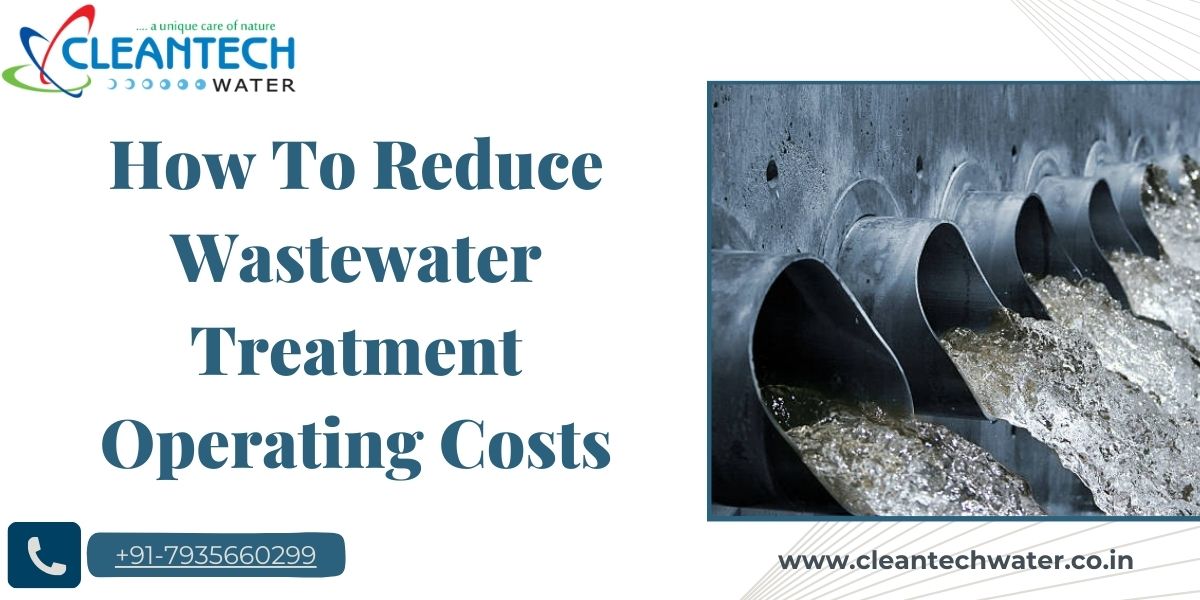Wastewater treatment plants are an essential component of the industrial landscape, ensuring environmental sustainability and compliance with regulatory standards. However, the costs of operating these facilities can be substantial, and businesses operating them need to explore strategies to remain competitive while maintaining profitability. To achieve this goal, it’s important to adopt practical approaches that can help reduce operating costs without compromising the quality or efficiency of the treatment process. In this article, we explore some of these strategies and how they can be implemented to achieve cost savings and operational efficiency.

What is the Average Cost to Run a Wastewater Treatment Plant?
The average cost to run a wastewater treatment plant varies depending on several factors. These include the volume of water processed daily, the type of sludge removal system in place, and the specific industry generating the wastewater. Despite these variables, there are four primary operational costs that every wastewater treatment facility will encounter:
Workforce Costs
One of the most significant expenses for wastewater treatment plants is the workforce. Skilled labour is essential for operating and maintaining the complex systems involved in treating sewage water. This includes roles such as plant operators, maintenance technicians, and administrative staff. By optimising staffing levels, providing comprehensive training programs, and implementing efficient scheduling practices, plants can minimise labour costs while ensuring operational effectiveness.
Waste Disposal Costs
Disposing of waste generated during the treatment process represents another substantial cost for the plants. This includes solid waste, such as sludge, and liquid waste discharged from the treatment process. To reduce disposal costs, plants can explore opportunities for waste minimisation and recycling. Additionally, investing in advanced treatment technologies that produce less waste or enable resource recovery can help mitigate disposal expenses in the long term.
Energy Costs
Energy consumption is a major operational expense for wastewater treatment plants, accounting for a significant portion of total operating costs. The treatment process requires electricity to power pumps, aerators, blowers, and other equipment essential for wastewater treatment. To lower energy costs, plants can implement energy-efficient technologies, optimise process control systems, and explore alternative energy sources such as solar or biogas. In addition, conducting regular energy audits can identify areas for improvement and inform targeted energy-saving initiatives.
Materials Costs
The procurement of materials and chemicals used in the treatment process also contributes to operational expenses for the treatment plants. These may include coagulants, flocculants, disinfectants, and filter media, among others. To minimise materials costs, plants can evaluate their chemical usage rates, optimise chemical dosing systems, and negotiate favourable contracts with suppliers. Furthermore, investing in innovative treatment methods that require fewer or less expensive materials can lead to long-term cost savings.
Proven Strategies to Reduce the Operational Cost of a Wastewater Treatment Plant
Efficiently managing operational costs is essential for the long-term sustainability and profitability of sewage treatment plants. By implementing strategic initiatives, businesses can effectively reduce expenses without compromising the quality of treatment processes. Here are ten actionable strategies to achieve cost savings and enhance operational efficiency:
1. Upgrade Pump Stations
Pump stations play a crucial role in transporting wastewater through treatment processes. Upgrading outdated pumps with modern, energy-efficient models can significantly reduce energy consumption and operational costs. Variable frequency drives (VFDs) and smart control systems allow for better pump optimisation, minimising energy wastage during periods of low demand. In addition, regular maintenance and proactive repair practices can extend the lifespan of pumps, reducing downtime and repair expenses.
2. Optimise Aeration
Aeration is a vital process in wastewater treatment, facilitating the removal of dissolved contaminants and improving water quality. However, excessive aeration can lead to unnecessary energy consumption and increased operational costs. By optimising aeration systems through the use of advanced controls and sensors, plants can adjust aeration rates based on real-time demand and oxygen levels in the water. Implementing fine bubble diffusers and optimising mixing patterns can further enhance aeration efficiency, resulting in significant energy savings over time.
3. Improve Sludge Management
Proper management of sludge generated during the treatment process is essential for minimising disposal costs and maximising resource recovery. Investing in dewatering equipment such as centrifuges or belt presses can reduce the moisture content of sludge, resulting in lower transportation and disposal expenses. Furthermore, implementing anaerobic digestion or composting processes can convert organic sludge into valuable biogas or fertilisers. This, in turn, generates revenue streams and reduces environmental impact.
4. Recover or Recycle Essential Nutrients
Wastewater contains valuable nutrients such as nitrogen and phosphorus, which can be recovered and reused in various applications, including agriculture and industrial processes. Implementing nutrient recovery technologies such as struvite precipitation or biological nutrient removal allows plants to extract valuable nutrients from wastewater effluent, reducing the need for costly chemical fertilisers. By establishing partnerships with local farms or fertiliser manufacturers, wastewater treatment plants can monetise nutrient recovery initiatives while promoting sustainability.
5. Reduce Chemical Disinfection
Chemical disinfection is commonly used in sewage treatment plants to eliminate harmful pathogens and ensure compliance with regulatory standards. However, excessive use of disinfectants such as chlorine or ozone can lead to high chemical costs and environmental concerns. Implementing alternative disinfection methods such as ultraviolet (UV) irradiation or chlorine dioxide can achieve effective pathogen removal while minimising chemical usage and associated expenses. In addition, optimising disinfection processes through the use of monitoring systems can ensure precise dosing and maximise cost-effectiveness.
6. Update Lighting and HVAC Systems
While the focus of wastewater treatment is often on process optimisation, improvements in facility infrastructure can also yield significant cost savings. Upgrading lighting systems to energy-efficient LED fixtures and installing programmable thermostats and high-efficiency HVAC units can reduce electricity consumption and lower utility bills. Also, implementing occupancy sensors and daylight harvesting technologies can further optimise energy usage, ensuring that lighting and climate control systems operate only when needed.
7. Leverage Gravity
Gravity can be a powerful supporter in wastewater treatment, especially when designing facility layouts and process configurations. By capitalising on the natural force of gravity, plants can minimise the need for energy-intensive pumping and conveyance systems. Strategic placement of treatment tanks, settling basins, and other process units can facilitate gravity-driven flow, reducing reliance on mechanical equipment and lowering operational costs. Furthermore, optimising pipeline gradients and minimising elevation changes can enhance hydraulic efficiency and reduce energy consumption throughout the treatment process.
8. Automate Operations
Automation plays a crucial role in streamlining wastewater treatment processes and optimising resource utilisation. By deploying advanced control systems, sensors, and monitoring devices, plants can automate routine tasks, such as flow regulation, chemical dosing, and equipment operation. Automated process control not only improves operational efficiency and consistency but also reduces the risk of human error and equipment malfunctions. By leveraging real-time data and predictive analytics, plants can identify opportunities for optimisation and continuously improve performance while minimising labour costs.
9. Adjust the Size of Installed Equipment
Over-sizing or under-sizing equipment can lead to inefficiencies and unnecessary costs in wastewater treatment plants. Conducting a thorough analysis of process requirements and capacity demands can help determine the optimal size and configuration of equipment, such as pumps, blowers, and treatment tanks. Rightsizing equipment not only minimises initial capital expenditures but also reduces energy consumption and maintenance costs over the long term. In addition, modular and scalable equipment designs offer flexibility and adaptability, allowing plants to adjust their capacity to meet changing operational needs.
10. Diagnose Costly Processes
Identifying and addressing inefficiencies in specific treatment processes is essential for achieving substantial cost savings in wastewater treatment plants. Conducting comprehensive process audits and performance evaluations can reveal areas of opportunity for optimisation and resource conservation. Whether it’s reducing hydraulic losses, optimising chemical dosage rates, or improving solids separation efficiency, diagnosing costly processes enables plants to implement targeted solutions that deliver measurable cost reductions. Furthermore, ongoing monitoring and performance tracking allow plants to assess the effectiveness of implemented measures and make further adjustments as needed.
Contact Us for Cost-Reducing Solutions for Your Wastewater Treatment Plants
Are you looking for ways to improve the efficiency of your wastewater treatment plant while reducing operational costs? Our team of experts is here to help you achieve your goals. We specialise in providing tailored solutions designed to maximise cost savings while maintaining regulatory compliance and environmental sustainability. We understand that every sewage water treatment plant is unique, and that’s why we offer personalised solutions tailored to your specific needs.
Our team will work closely with you to identify opportunities for improvement and recommend innovative technologies that can help you optimise your operations. Whether you need to upgrade your equipment, automate your processes, or enhance your resource recovery capabilities, we’re here to help. Our solutions are designed to deliver measurable results, so you can see the impact of our work on your bottom line.
If you’re facing challenges in maintaining your plant’s wastewater treatment operations due to increasing operational costs, we’re here to help. Our team of experts can assist you in achieving sustainable cost reductions while simultaneously improving your plant’s performance. Get in touch with us today to explore how we can empower your sewage treatment operations and take them to the next level. Contact us at +91-9099915539 or +91-9558996411 for a complimentary consultation.

